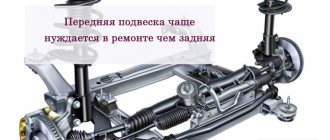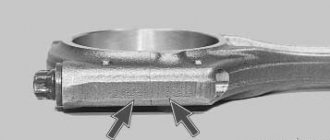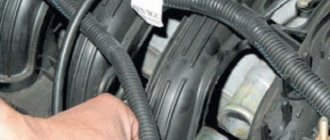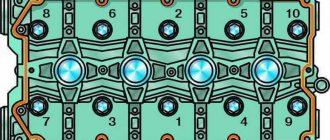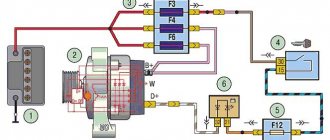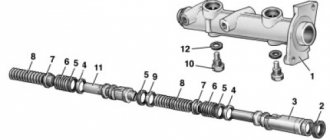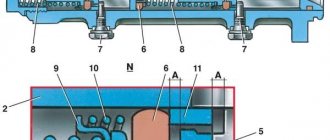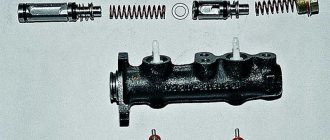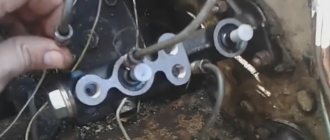Not long ago, a standard problem with VUT appeared - air is being cut and because of this the engine is unstable. I decided to change the VUT, but then a problem arose, one of the studs securing the GTZ was torn off, not torn off, but rather the thread was torn off, in the end I decided not to install a stock part, but to install something more retarding.
This story was very long and a lot of problems arose, but in the end we acquired: Pedal assembly from a 2013 Priora. some kind of super-mega-new model - 1300 rubles (pedal + VUT + GTZ + 2 pieces of fittings per ABS block) VUT Priora/Kalina - 2000 rubles GTZ 21214-3505010-03 - 1400 rubles GTZ tank round from shnivy - 100 rubles Brake fluid 1l - 100 rubles
In general, the set of VUT Priora + GTZ 21214 + pedal bracket fits almost perfectly, except for the unknown brake light switch...
Replacing the master brake cylinder
On Lada Priora cars, master brake cylinders manufactured by MANDO - Korea were most often installed from the factory.
It is worth noting that the parts from this manufacturer are of quite high quality and rarely fail, but if such a problem occurs, it is necessary to replace this part with a new one. So, in order to replace the master brake cylinder on a Priora with your own hands, you will need the following tool:
- 13mm split wrench
- 10 mm head
- Ratchet or crank
Main signs of GTZ breakdowns
Lada The main task of this unit is to uniformly distribute the working fluid of the hydraulic system along the contours. Therefore, the slightest imbalance leads to a decrease in braking efficiency. To determine the condition of the master cylinder or the need to replace it, experts advise paying attention to factors such as:
- readings of the warning lamp on the dashboard;
- brake oil leaks;
- cracks on the body
If at least one of these signs is detected, repairs should be started immediately. It is possible, of course, to partially restore defective parts, but practice shows that it would be more rational to install a new assembly.
Removal and installation of GTZ on Priora
The first step is to pump out the brake fluid from the reservoir using a syringe and flexible tube. Then we disconnect the power connector chip from the tank cap, or unscrew it entirely.
After this, unscrew the two brake pipes on the right side of the GTZ, as shown in the photo below.
The best option is to use a special split wrench designed for unscrewing brake pipes and hoses. The result of the work done is presented below.
If there is liquid left in the tank, you need to place a container or a dry cloth to drain the remaining liquid. Then we take the head with the ratchet and unscrew the two nuts securing the master cylinder to the vacuum booster.
One is higher and the second is lower. As a result, it is possible to remove the GTZ without any problems.
If it is necessary to replace the cylinder with a new one, we buy the part and install it in the reverse order. It is worth noting that when adding brake fluid to the reservoir, air may enter the system. If this happens, it is necessary to bleed the brake system through special fittings in the cylinders.
The price of a new GTZ for Priora is from 1,500 rubles for the original. It is worth noting that you can buy a high-quality spare part from a car disassembly for half the price of a new one.
Leave a reply Cancel reply
You must be logged in to post a comment.
Source
Your advantages when purchasing at Autocompas.ru
- Huge selection of auto parts and low prices;
- Fast delivery, usually within 24 hours;
- Warranty and right of return;
- Emphasis on proven and branded manufacturers of all price segments;
- Safe and convenient online purchase with many payment options;
- Qualified support and advice + recommendations from experts when choosing and purchasing.
Range of auto parts in stock and on order
A wide variety of manufacturers and high-quality auto parts guarantee the mobility of your car and safety on the roads. A huge assortment is constantly available from stock online. Certified and reliable aftermarket suppliers, dealers, and regional market participants provide a full range of auto parts at reasonable prices. Our knowledgeable support staff is always available to assist you in your search.
Quality of service in our online store
The service and online offers from Autocompas.ru have already won several awards and made us a leader in the Russian market in the field of sales of auto parts for foreign cars, 40+ thousand people visit the site every day and many of them become our regular customers. Satisfied customers are our goal. Rely on Autocompas.ru as a reliable supplier of auto parts.
29.11.2019
A review section has been introduced on the site, using the latest technologies, now each client can write a review from their personal account.
01.01.2019
A completely new and intuitive returns system.
23.05.2018
Global update of the “Delivery” section! Track numbers in your personal account and convenient cargo tracking.
Removing the master cylinder
We carry out the work when replacing the main brake cylinder and to remove the vacuum brake booster. To gain access to the nuts securing the master brake cylinder to the vacuum booster, it is necessary to unscrew the self-tapping screw of the lower fastening of the bulkhead trim (see “Removing the bulkhead trim”). Having unscrewed the tank cap, remove the cap along with the liquid level sensor. (see “Checking the fluid level in the hydraulic brake reservoir”). Use a rubber bulb to remove liquid from the reservoir.
Using a special “13” wrench for brake pipes, loosen the tightening of the fittings of the two brake pipes.
Using a 13mm socket, unscrew the two nuts securing the cylinder to the vacuum brake booster. Carefully bending the brake pipes, remove the master cylinder from the vacuum booster studs.
Description of the VAZ 2170 hydraulic brake drive system
The design of the system is based on a dual-circuit circuit with diagonal distribution. That is, one circuit combines the drive mechanisms of the right front wheel and the rear left wheel, the second - the left front and rear right wheels. If one of the circuits fails, the second will be activated, which will ensure an effective shutdown.
The brake drive circuit consists of:
- brake mechanisms;
- master brake cylinder;
- vacuum booster;
- pipelines;
- tank GTZ;
- pressure regulator;
- brake pedal.
A cylinder with a two-section fluid reservoir is attached to the amplifier cover. It itself has two pistons arranged in series. During operation, the pistons wear out and cannot be repaired - only replaced.
Description of design
The service brake system is hydraulic, dual-circuit, with diagonally separated circuits. In normal mode, when the system is working properly, both circuits operate. If one of the circuits fails (depressurizes), the other circuit provides braking to the vehicle, although with less efficiency.
Elements of the brake system : 1 — front wheel brake disc; 2 — front wheel brake tube; 3 — front wheel brake hose; 4 — hydraulic drive reservoir; 5 — main brake cylinder; 6 — vacuum booster; 7 — brake pedal; 8 — rear wheel brake tube; 9 — pressure regulator; 10 — rear wheel brake mechanism; 11 — rear wheel brake hose; 12 - floating bracket
The service brake system includes wheel brakes, a pedal assembly, a vacuum booster, a master cylinder, a hydraulic reservoir, a pressure regulator in the rear wheel brakes, as well as connecting tubes and hoses.
The brake pedal is a suspended type. A brake signal switch is installed in the pedal bracket - its contacts close when the brake pedal is pressed. Pedal assembly with vacuum booster and main brake cylinder : 1 - brake pedal;
2 — brake pedal bracket; 3 - vacuum booster; 4 — hydraulic drive reservoir; 5 - main brake cylinder The vacuum brake booster is located between the brake pedal and the main brake cylinder and is attached with two nuts to the brake pedal bracket, which, in turn, is attached to the body. The vacuum amplifier is non-separable; if it fails, it is replaced with a new one. The brake master cylinder is attached to the vacuum booster housing with two studs. On top of the cylinder there is a reservoir for the hydraulic drive of the brake system, which contains a supply of fluid. There are markings for the maximum and minimum liquid levels on the tank body, and a liquid level sensor is installed in the tank lid, which, when the liquid level drops below o, turns on the alarm in the instrument cluster. When you press the brake pedal, the pistons of the master cylinder move, creating pressure in the hydraulic drive, which is supplied through tubes and hoses to the working cylinders of the wheel brake mechanisms.
Technology for replacing a faulty brake master cylinder on a Lada Priora
To work you will need a set of tools:
- a set of keys;
- rubber bulb;
- screwdrivers with flat and Phillips (PH 2) tips.
To access the mount, you must first remove the decorative trims of the windshield frame and the soundproofing upholstery.
, unscrewing the screws. Now you can get started:
- Unscrew the cap of the tank and pump out the liquid from it with a rubber bulb.
- Release the tank clamps and remove it from the GTZ.
- Use a special wrench to “13” to remove the pipelines.
- Unscrew the two nuts securing the cylinder to the vacuum booster.
- Remove the cylinder
- Install the new part in reverse order.
During installation, pay attention to the condition of the sealing ring and, if necessary, replace it. After the operation, be sure to bleed the hydraulic drive.
Removing the master brake cylinder Lada Priora (VAZ-2170)
We carry out the work when replacing the main brake cylinder and to remove the vacuum brake booster.
To gain access to the nuts securing the master brake cylinder to the vacuum booster, it is necessary to unscrew the self-tapping screw of the lower fastening of the bulkhead trim (see “Removing the bulkhead trim”).
Having unscrewed the tank cap, remove the cap along with the liquid level sensor. (see “Checking the fluid level in the hydraulic brake reservoir”). Use a rubber bulb to remove liquid from the reservoir.
Using a special “13” wrench for brake pipes, loosen the tightening of the fittings of the two brake pipes.
Using a 13mm socket, unscrew the two nuts securing the cylinder to the vacuum brake booster. Carefully bending the brake pipes, remove the master cylinder from the vacuum booster studs.
Using a 13mm wrench, unscrew the fittings of the two brake pipes. We remove the tube tips from the holes of the master brake cylinder...
...and remove the brake master cylinder complete with the reservoir.
The connection between the master cylinder and the vacuum brake booster is sealed with a rubber ring. To remove the tank...
... we move away the two legs of the tank body and remove them from the bosses of the cylinder body. Overcoming the resistance of the rubber sealing bushings, we remove the tank fittings from the cylinder holes...
...and remove the tank. If it is necessary to replace the sealing sleeve...
...remove it from the cylinder body. We assemble the brake master cylinder with the reservoir and install it in the reverse order.
After installation, we bleed the brake system hydraulic drive.
